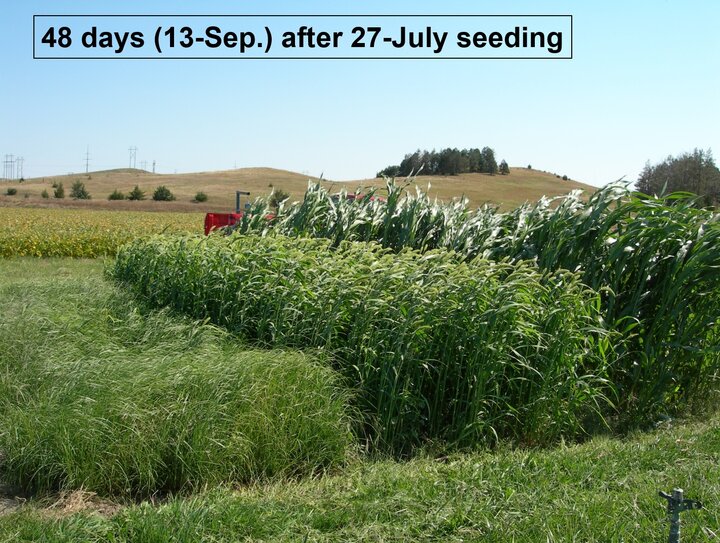Dry conditions in many parts of the state are challenging producers to consider options for growing additional forage to provide feed for this fall and winter. In some parts of the state, less than 50% of long-term average precipitation has been received from the middle of April to the middle of June. This has severely impacted forage production from perennial dryland hay fields as well as yields from winter and spring annual forages.
These dry conditions and forage shortages are prompting many producers to consider what other annual forages can be planted with what remains of the summer to grow additional feed. Summer annuals are a good option when planted through the end of July. Research done by Dr. Volesky at the West Central Research and Extension Center has shown that with adequate moisture and soil fertility, late July planted summer annuals can be quite productive, producing 2 to 4 tons of forage per acre.

Another option is spring annual forages such as oats, spring triticale and barley planted in late July through the middle of August, which can provide high quality feed. These can also be planted with turnips, forage rape, or other species used in cover crop mixtures. This forage can be harvested, direct grazed, or windrow grazed from October into the winter.
Spring annual forages can also be planted in a mix with winter annuals such as winter wheat, rye, or triticale. With this approach, the spring annual will provide the majority of the fall forage while the winter annual will provide additional grazing the following spring.
Spring annuals with adequate fertility, moisture and growing days can accumulate 1.5 to 3 tons of forage per acre when planted in late July to the middle of August. The earlier the planting date, the more total forage is likely to be produced. Spring annuals are somewhat cold tolerant, with standing light frosts. Once temperatures drop to the lower 20’s and upper teens, the plants will begin to die and lose their green color.
For areas where wheat is being grown under irrigation, planting annual forages after wheat has been harvested can be an excellent way to grow additional forage. This practice can also be applied on dryland wheat acres should summer rainfall become abundant and soil moisture is adequate to support growing an additional crop.
Research at the High Plains Ag Lab at Sidney, has shown that late summer planted oats can maintain quality amazingly well through the winter. Data from standing oats planted in late July and early August of 2012 harvested and analyzed in early March of 2013 showed oats at 13% crude protein with total digestible nutrients (TDN) values in the mid 60’s. Similarly, trials at the West Central Research and Extension Center in North Platte found late October yields of 3 to 4 tons/acres with crude protein content ranging from 13 to 17%. TDN values were also in the mid 60’s. This is better quality than many types of hay often being fed at this time of year! For more information on using annual forages after irrigated wheat see the UNL NebGuide “Utilizing Annual Forages with Limited Irrigation for Beef Cattle During and Following Drought”. Usually spring annuals are planted in March or April as a summer forage source. However, these spring annuals when planted in the middle of summer can also provide high quality feed for the fall and winter.
Interviews with the authors of BeefWatch newsletter articles become available throughout the month of publication and are accessible at https://go.unl.edu/podcast.

